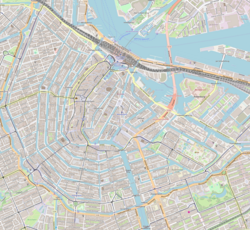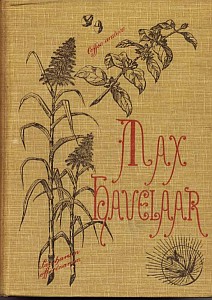
Max Havelaar; or, The Coffee Auctions of the Dutch Trading Company is an 1860 novel by Multatuli, which played a key role in shaping and modifying Dutch colonial policy in the Dutch East Indies in the nineteenth and early twentieth century. In the novel, the protagonist, Max Havelaar, tries to battle against a corrupt government system in Java, which was then a Dutch colony. The novel's opening line is famous: "Ik ben makelaar in koffie, en woon op de Lauriergracht, Nº 37.".

Eduard Douwes Dekker, better known by his pen name Multatuli, was a Dutch writer best known for his satirical novel Max Havelaar (1860), which denounced the abuses of colonialism in the Dutch East Indies. He is considered one of the Netherlands' greatest authors.

Menno ter Braak was a Dutch modernist writer, critic, essayist, and journalist.

Eduard Cuypers was a Dutch architect. He worked in Amsterdam and the Dutch East Indies.
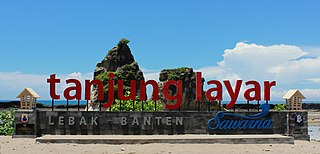
Lebak Regency is a regency of Banten province, Indonesia. It is located on the island of Java. The regency has an area of 3,305.072 km² and an population of 1,204,095 at the 2010 Census and 1,386,790 at the 2020 Census. The town of Rangkasbitung in the north of the regency is the administrative centre. The regency is bordered by Pandeglang Regency to the west, Serang Regency to the north, and Tangerang Regency to the north-east, and by Bogor Regency and Sukabumi Regency of West Java Province to the east.

Ernest François Eugène Douwes Dekker also known as Setyabudi or Setiabudi was an Indonesian-Dutch nationalist and politician of Indo descent. He was related to the famous Dutch anti-colonialism writer Multatuli, whose real name was Eduard Douwes Dekker. In his youth, he fought in the Second Boer War in South Africa on the Boer side. His thoughts were highly influential in the early years of the Indonesian freedom movement.

Wolter Robert Baron van Hoëvell was a Dutch minister, politician, reformer, and writer. Born into nobility and trained in the Dutch Reformed Church, he worked for eleven years as a minister in the Dutch East Indies. He led a Malay-speaking congregation, engaged in scholarly research and cultural activities, and became an outspoken critic of Dutch colonialism. His activism culminated when he acted as one of the leaders of a short-lived protest in 1848. During the event, a multi-ethnic group of Batavian inhabitants presented their grievances to the local government. As a result of his leadership in the protest, van Hoëvell was forced to resign his position in the Indies.

Wilhelmina Jacoba Pauline Rudolphine "Mina" Kruseman was a 19th-century Dutch feminist, actrice and author who used to call herself Oristorio di Frama.

Alexander Willem Frederik Idenburg was a Dutch military officer and politician of the Anti Revolutionary Party who served as Governor-General of Suriname from 1905 until 1908, and the Dutch East Indies from 1909 until 1916. He also served as Minister of Colonies on three occasions between 1902 and 1919. Idenburg served on the Council of State from 1925 until his death in 1935.
Rangkasbitung is a town which is administrative centre of Lebak Regency, in Banten Province of Java, Indonesia. It had a population of 134,950 at the 2020 Census.
August Aimé (Guus) Balkema, or A.A. Balkema, was a Dutch book trader and publisher active in Amsterdam and South Africa. He played a prominent role in the South African publishing world and was included in They shaped our century (1999), a list of the 100 most influential people in South Africa in the 20th century.
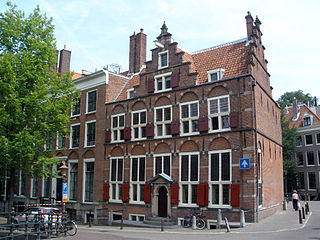
The Huis aan de Drie Grachten or Huis op de Drie Grachten is a 17th-century canal house in Amsterdam, at the southeastern end of the Wallen district. The name is a reference to the fact that the building faces three different Amsterdam canals. The south facade faces Grimburgwal, the west facade faces Oudezijds Voorburgwal and the east facade faces Oudezijds Achterburgwal. The address is Oudezijds Voorburgwal 249.

Dutch Indies literature or Dutch East Indies literature is the Dutch language literature of colonial and post-colonial Indonesia from the Dutch Golden Age to the present day. It includes Dutch, Indo-European and Indonesian authors. Its subject matter thematically revolves around the VOC and Dutch East Indies eras, but also includes the postcolonial discourse.
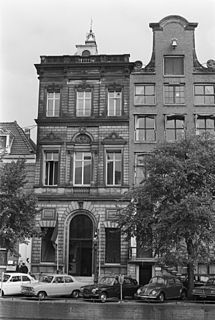
Museum Fodor is a former art museum in Amsterdam in the Netherlands. The museum was located at the Keizersgracht in Amsterdam-Centrum in the building that currently houses the Foam Fotografiemuseum Amsterdam.

Het Nieuws van den Dag voor Nederlandsch-Indië was a Dutch-language newspaper published on the island of Java in the Dutch East Indies. Originally called De Indische Courant, it was published in Batavia from 1895 or 1896 to 1900 until it was renamed. One of the paper's contributors was Dutch author and critic of the colonial system Multatuli.
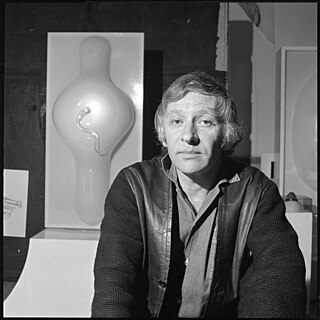
Matheus Josephus Lambertus (Mathieu) Ficheroux was a Dutch artist, who worked as sculptor, glass painter, painter, draftsman, wall painter and installation artist. He is considered among the foremost Dutch artist of the second part of the 20th century.
The Multatuli Prize is a Dutch literary prize that is given every year to an author for exemplary writing in Dutch language.

The Lauriergracht is one of the canals of Amsterdam, located in the Jordaan, west of the Grachtengordel.
The Multatuli Museum is a museum located in Rangkasbitung, Banten, Indonesia. Its focus is the author Multatuli, who lived in the area in the 1850s and used it as the basis for his famous anti-colonial novel Max Havelaar. The museum also examines Dutch East Indies colonial history, the anti-colonial movement, and the local history of Rangkasbitung. There is another Multatuli Museum in Amsterdam which houses many of the author's personal papers.

